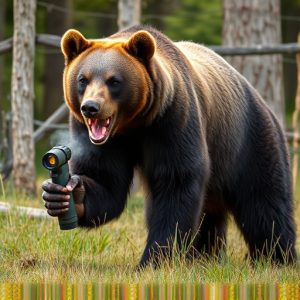Mastering Bear Repellent Spray: When, How, and Why It’s Essential
Bears, integral to ecosystems, pose a safety concern for campers, especially in areas rich in food s…….
Bears, integral to ecosystems, pose a safety concern for campers, especially in areas rich in food sources during spring and fall seasons. Bear spray, a vital tool for adventurers in bear-inhabited areas, uses capsaicin and volatile oils to deter bears through irritation. Effective usage involves employing it as a last resort within 20-30 feet against aggressive bears, targeting their face and eyes. Safety guidelines, proper storage, and regular testing are crucial for maximizing its effectiveness, ensuring personal safety while camping or hiking in bear country.
“Enhance your camping experience and ensure safety in the wilderness with a crucial tool—bear repellent spray. This comprehensive guide explores why it’s an essential addition to your outdoor kit. Learn about bear behavior, understand the science behind its effectiveness, and discover how to choose and apply the right spray for maximum protection. From understanding encounter risks to safe handling practices, this article equips campers with knowledge on when and how to use bear spray properly.”
- Understanding Bear Behavior: When and Where to Expect Encounters
- The Science Behind Bear Spray: How Does it Work?
- Choosing the Right Bear Spray for Your Camping Needs
- Application Techniques: Ensuring Maximum Effectiveness
- Safe Handling and Storage Practices for Bear Repellent Spray
Understanding Bear Behavior: When and Where to Expect Encounters
Bears, an integral part of many ecosystems, are powerful and unpredictable animals. Understanding their behavior is key to ensuring a safe camping experience. Knowing when and where bear encounters are most likely to occur can help campers prepare accordingly. Bears are primarily attracted to food sources, so areas with abundant berries, nuts, or campgrounds near water bodies are hotspots for potential interactions. They are also more active during certain times of the year, especially during spring and fall when food is scarce and winter hibernation approaches.
When it comes to using bear spray properly, timing is crucial. It should be employed as a last resort when a bear exhibits aggressive or defensive behavior, such as charging or making loud noises. Bear spray is most effective at close range, typically within 20-30 feet, and it disrupts the bear’s sense of smell and vision, temporarily deterring them. However, it’s important to remember that no method is foolproof, and bears may still approach despite the use of repelents.
The Science Behind Bear Spray: How Does it Work?
Bear spray, also known as bear repellent, is a crucial tool for campers and outdoor enthusiasts navigating bear country. Its effectiveness lies in a unique combination of chemicals designed to deter bears when used correctly. The active ingredients in bear spray typically include capsaicin, a compound found in chili peppers, and various volatile oils. When sprayed, these substances create an intense irritation in the bear’s eyes, nose, and throat, temporarily disorienting it and encouraging a quick retreat.
Understanding how bear spray works is essential for its proper usage. It should be used as a last resort when a black or grizzly bear exhibits aggressive behavior or approaches closely. Campers should practice using the spray before heading into the wilderness to ensure they can deploy it effectively if needed. The key is to aim for the bear’s face and eyes, creating a barrier of spray that disrupts its sense perception, allowing campers to safely move away from the area.
Choosing the Right Bear Spray for Your Camping Needs
When selecting bear repellent spray for your camping trips, understanding its purpose and effectiveness is key. Different situations call for varying strengths and types of bear spray. For instance, if you’re primarily hiking in areas known for black bears, a lighter concentration may suffice as these bears tend to avoid humans. However, grizzly encounters require higher concentrations designed to deter larger, more aggressive bears. Check product labels for information on recommended use cases, ensuring it’s suitable for the specific bear species prevalent in your camping region.
Proper usage is equally important. Bear spray should be used as a last resort when faced with an unexpected encounter. Spraying should begin at close range, usually within 20-30 feet, and target the bear’s face and eyes to temporarily blind it and create confusion, allowing you to retreat safely. Always follow safety guidelines provided by the manufacturer and stay alert during your outdoor adventures to minimize the need for such a powerful tool.
Application Techniques: Ensuring Maximum Effectiveness
To ensure maximum effectiveness of bear repellent spray, understanding and employing proper application techniques is crucial. When to use bear spray properly involves assessing the situation, as close-range encounters require a different approach than distant ones. At close range, aim for the face and chest area, where scent glands are located, spraying in quick bursts. This tactic disrupts the bear’s sense of smell, potentially deterring an attack. For longer distances, focus on creating a barrier between you and the bear by spraying in sweeping motions, covering the animal’s line of sight.
Remember that consistency is key; maintain a steady stream or series of bursts as you retreat. It’s also important to keep your spray ready at all times during camping trips, as bears can be unpredictable. Regularly test the spray before and during your trip to ensure it remains potent and check expiration dates to stay prepared when venturing into bear country.
Safe Handling and Storage Practices for Bear Repellent Spray
When using bear repellent spray, safety should always be a top priority. It’s crucial to handle and store the spray correctly to ensure its effectiveness and prevent accidental misuse. Keep the canister in a secure, child-proof location, out of reach and sight, especially during meals or when setting up camp. Always inspect the spray for any signs of damage before each trip and check the expiration date to guarantee potency.
During application, follow the instructions on the label meticulously. When to use bear spray properly is both situational (e.g., in close encounters) and contextual (e.g., in areas known for high bear activity). Storing it appropriately and using it defensively are key practices that contribute to its reliability as a tool for personal safety during camping or hiking in bear country.
When planning your next camping trip, especially in bear-inhabited areas, packing a reliable bear repellent spray is an essential part of your safety kit. Understanding bear behavior and knowing when to use bear spray properly can significantly enhance your outdoor experience. By choosing the right spray, learning application techniques, and adhering to safe handling practices, campers can effectively deter bears and enjoy their time in nature without concern. Remember, prevention through proper preparation and awareness is key when navigating potential bear encounters in the wild.


